Behringer WASP DELUXE Legendary Analog Synthesizer with Dual OSCs, Multi-Mode VCF, 16-Voice Poly Chain and Eurorack Forma
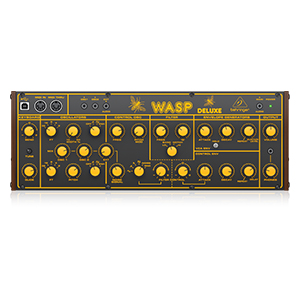

WASP DELUXE
Legendary Hybrid Synthesizer with Dual OSCs, Multi-Mode VCF, 16-Voice Poly Chain and Eurorack Format
- Legendary Hybrid synthesizer with dual digital OSC design allows for insanely fat music creation
- Authentic reproduction of original “Wasp Deluxe†circuitry
- Pure analog signal path based on authentic VCF and VCA designs
- 3 variable oscillator shapes with pulse / ramp and enhanced mode for ultimate sounds
- Multi-mode VCF with Lo, Hi, Band and Notch modes
- 2 analog Envelope Generators for modulation of VCF and VCA
- Noise generator dramatically expands waveform generation
WASP DELUXE
| | | | |
|---|---|---|---|
WASP DELUXEThe 1970s spawned the first truly portable analog synthesizer, and while it was quickly adopted by lots of renowned musical artists including Jan Hammer, Chick Corea, Rick Wakeman, Jean-Michel Jarre, Isao Tomita and Keith Emerson to name a few, it was somewhat temperamental and very expensive. In 1978 a unique and quirky little synthesizer was born. The Wasp, as it was called, was a monophonic, two-octave keyboard that used touch-sensitive keys. It was a novel idea back then but tended to be unreliable and difficult to play. An ultra-affordable homage to that iconic synthesizer, with all the features of the original and then some, the Behringer WASP DELUXE lets you conjure up virtually any sound imaginable with incredible finesse and ease. Pure analog signal path based on authentic VCF and VCA designs in conjunction with a flexible 6-shape waveform LFO including noise and S&H with frequency and pitch modulation control. | True to the OriginalGreat care has been taken in designing the WASP DELUXE including the true to the original “Wasp Deluxe†circuitry. This is what gives it its ultra-flexible sound shaping capability, which covers everything from super-fat bass and lead tones, stunning effects – and all the way out to the otherworldly sounds of your imagination. | Big, Fat TonesThe inspired synthesizer tracks laid down in the 1970s and ‘80s are etched in the annals of progressive rock, wave and synth-pop music forever, making them truly classic in every sense of the word. WASP DELUXE’s pure analog signal path based on authentic VCF and VCA designs, lets you recreate all of that magic – or design incredibly fat and original sounds that will make you a legend in your own right! | Variable OscillatorsMore than just being true to the original, we just had to add more features. Each of the two oscillators comes with three variable waveforms: sawtooth, square wave and an enhanced mode which adds punch and some clarity to the oscillator’s tone. Both oscillators can be adjusted across a wide 5-octave range (32’, 16’ 8’, 4’ and 2’). Oscillator 1’s wave shape can be adjusted via the Width knob, while oscillator 2 has a pitch control that can be adjusted against oscillator 1’s pitch to create some really sweet modulation effects. To top it all off, these can be mixed and blended together with an external audio signal to get a truly unique sound. |
WASP DELUXE
| | | |
|---|---|---|
Even More ControlThe Control Oscillator section is where things start to get interesting. This section features a flexible LFO with six waveform shapes such as a sine wave, rising sawtooth, falling sawtooth, square wave, noise and random which can be further manipulated with the Frequency and Pitch knobs. A noise generator that dramatically expands waveform generation and can be mixed in to create additional percussion sounds. The WASP DELUXE also comes with a switchable, multi-mode VCF with Lo, Hi, Band and Notch filter options as well as a Freq and Q setting where you can play with the filter cutoff and width to get some really wild sounds that can add some spice to your music. | Pushing the EnvelopeNext in the chain is where you can create some very intricate patches. The WASP DELUXE has two analog Envelope Generators for modulating the VCA and VCF. The VCA Envelope section contains an Attack, Decay, Sustain Level/Repeat knob as well as a hold switch that can be used to sustain a note indefinitely while the Control Envelope features Attack, Decay and Delay/Repeat knobs. Set these just right to get millisecond-quick notes ala Kraftwerk or create long atmospheric synth beds just like Vangelis in Bladerunner. | 16-Note Poly Chain ReadyWhile it is a monophonic instrument (one note at a time), WASP DELUXE’s 16-note Poly Chain function lets you combine multiple synthesizers for up to 16-voice polyphony – plus provides vastly improved reliability and stability over its 1970’s predecessor. |
WASP DELUXE
| | | |
|---|---|---|
Eurorack ReadyDesigned to handle the rigors of life on the road or in the studio, your WASP DELUXE can easily be transferred into a standard Eurorack case for the perfect integration into your existing system. | Controls & ConnectivityWe just can’t help ourselves – like you, we’re gear-heads, too. For those who want the numbers, WASP DELUXE has 29 controls, all laid out in a highly intuitive format that puts the joy back into your music creation. Input and output connections include: MIDI I/O and Thru over USB/MIDI DIN; Main Audio via a 3.5mm TRS connection; LOW and HIGH Main outs via a ¼” TRS connection. | Unleash Your ImaginationWhen it comes to not just pushing envelopes but creating them, WASP DELUXE gives your imagination its voice – and it’s so very affordable. When modern performance calls for classic analog sound – it calls for the Behringer WASP DELUXE! Visit your dealer to experience the stunning WASP DELUXE or get yours online today. Music never felt this good! |
| Weight: | 1.1 kg |
| Dimensions: | 49 x 19 x 13 cm; 1.1 Kilograms |
| Model: | WASP DELUXE |
| Colour: | Black |
| Colour: | Black |
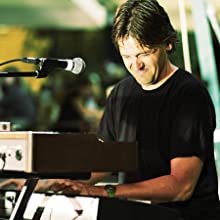


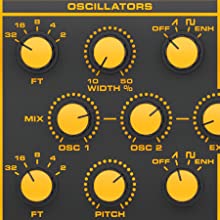
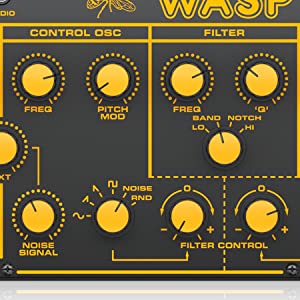
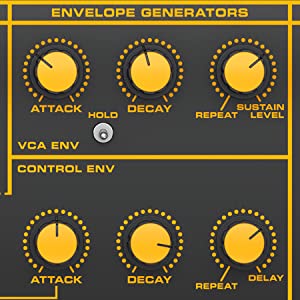
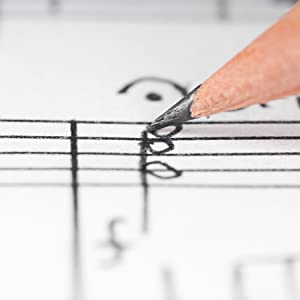
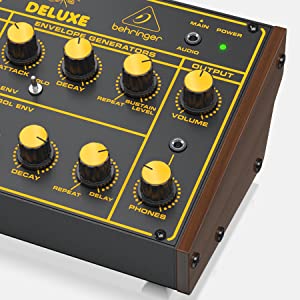


El Behringer Wasp Deluxe es un instrumento nico. Su sonido grueso y agresivo no tiene igual y su filtro multimodo te dejar sin palabras. Muy bien que adems el nmero de serie de la unidad que me han mandado empieza por S20, lo que significa que es la versin v2 del hardware con el problema corregido de las notas que se disparaban solas. Muy contento con la compra y ms a este precio tan bajo.
I Love it.
I’m really getting into synths by Behringer.
I also have Roland, Korg and Novation.
If you yourself are interested in this synth then
I definitely would give you advice into looking at the Behringer Pro 1 and the Behringer Neutron.
Sonido interesante, sucio y nico. Suena muy bien, yo no lo recomendara como primer sintetizador por lo limitado que es y lo peculiar de sus sonido. Construccin robusta y de metal, si se pudiesen controlar los parmetros por MIDI ya sera la leche, pero bueno, al ser tan simple es fcil recordar los parmetros para los sonidos
Extraordinaire petit synth, assez droutant au dballage pour un dbutant comme moi mais qui s’apprivoise en une paire d’heures. La palette de sons n’est videmment pas extensible l’infini mais ce n’est pas son rle, vu le prix : il aura sans doute de la compagnie, d’autres modules Behringer ou de chez les concurrents. Pour ma part j’utilise le Wasp appair en MIDI avec un vieux Korg M3R d’occasion et ce duo extrmement abordable me permet de toucher peu prs toutes les poques et tous les styles de sons synthtiques.
Il a de la personnalit, c’est le principal, et il est bien ancr dans l’poque de son modle, le “vrai” Wasp clavier membranes. Enfin, la qualit des potentiomtres semble bonne et les slecteurs crants produisent un clic franc et rassurant. On est loin du plastique argent de la copie de la Roland 303, qui vieillira sans doute nettement plus mal.
En bref, une surprenante petite machine au prix d’un simple jouet.
This was on offer for a really great price. It’s a clone of a classic British synthesizer from the early 70s.
The build quality is great with a metal chassis and wooden end cheeks. The knobs are solid and sturdy.
I bought this for little over the price of a Korg Volca so it was an absolute steal.
It’s quite a simple synth, and very hands on. The simplicity means you can dial in sounds very quickly.
It’s got a very distinctive buzzy sound, but you can tame it using the filter cutoff. The two envelopes can be set to loop, and this – along with the LFO – can allow you to create simple rhythmical sequences.
The filter has some nice harmonics when the resonance is set high. It won’t self oscillate though. It has low pass, notch, band pass, and high pass settings. There’s a lot of characters to it.
It has a nice vintage sound, and you can get some great bass, and lead sounds.
I really like this synth. It’s architecture is simple, but you can get a fair range of usable sounds from it. It means you spend your time making music rather than scratching your head.
The original design dates from the early ’80s, around 1981, when British electronics inventors were really playing with new shapes and ideas. The Electronic Dream Plant (EDP) Wasp was like the SInclair ZX80 of synths; a flat membrane keyboard, a cheap vacuum-formed case, and power for under 200 (in 1980s money) beyond any previous synth. It had connectivity for chaining, a built in speaker – think ‘MicroFreak’s cranky great uncle’ and you’re there.
The Wasp’s sound can harsh, bright, powerful – it cuts through mixes and is precise, capable of distortion and yet not without warmth, in part due to the highly flexible multimode analogue filter that can shape and slice sound with a variety of approaches when most rivals only offered one.
The original was immensely fragile though, and few survive. These days a good original one will cost seven or eight times the price of the Behringer.
The Behringer Wasp:
It’s an accurate clone – and this isn’t a surprise because the Wasp has been cloned many times, but never for such a low price before. Sound-wise you’ll find it amazingly accessible and easy to program; it can distort and sound harsh and metallic quite easily. Shove it through some effects and you’ll get a lot of mid-80s basses, solo leads and industrial-style percussion.
There’s no patch storage or sequencer, but you do get MIDI – you don’t get CV because the Wasp isn’t analogue. There is, however, an external audio in so you can use the Wasp’s analogue filter, which can be pushed to the harsh, screaming industrial anger side or warm gloopy Moog-like sounds. You can also tap the two oscillator outputs individually.
You want something different to all those warm analogue clones anyway, right?
For beginners:
What sets the Wasp apart is the filter, which can do low-pass (like a 303, cutting off the high frequencies), band-pass, notch or high-pass. This means you can do the classis ‘head going underwater/covering your ears’ cutoff sweep, the ‘slicing the bass out’ sounds like overhead headphones, and also enhance or suppress a narrow band of frequencies with a very excitable resonance around that band if you want.
These effects can be applied to other small instruments, as an effect on a mixer, or to music/samples via the audio in.
The actual voice of the Wasp is also pretty good – two stable oscillators that don’t need a warm up time or overly faffing to adjust the tune of. Simple waveforms and mixing can be augmented with noise and pitch modulation as well as the filter and amp envelopes. It’ll do fat basses but can also indulge in a bit of retrogaming chiptune silliness too.
Wasp is very easy to get to know. It’s not full of complex routings, but has some neat features such as filter envelope repeat that can make weird and wonderful or gated dance sounds with ease. MIDI control is available through old-school DIN or USB, and it doesn’t need much setup – start with the basic patch, and play. You can set MIDI channel in the software, or use little dip switches – great if you’re polychaining or using these in a touring rig where the security of hardware MIDI channels ensures easy setup.
You’ll need a controller – just a basic Arturia KeyStep or Behringer’s compact MIDI keyboard will do as there’s not much need for anything more than note input; the original Wasp only had touch pads, and they also add sequencer features.
For pros:
For the price you’re not going to get anything like this as a set of modules – the multimode filter is worth it alone. There’s no external triggering though unless via MIDI, so you’re going to have to get creative to integrate the envelopes in your sounds. The oscillators are stable with good waveshapes that ultimately formed the basis of many Novation synths (the designer of the Wasp went on to design the Nova/BassStation and the architecture of the Peak/Summit). Early examples of the Wasp had multi trigger bugs, so buying new is worthwhile over grabbing a used one.
At this price you can get four and polychain them for a very impressive, versatile four-voice, eight DCO polysynth.
For use in a rack the USB and MIDI ports are on the front, as is a 3.5mm jack audio output, the oscillator outputs and the audio in; there’s also a 1/4″ output. On my Wasp background noise is present when the gain’s up on the mixer but few patches need that kind of staging, it’s quite loud and easy to sculpt sounds.
Rackmount ears are not expensive, and you can get creative for an angled mount – check the pics.
Personally, I always wanted an original EDP Wasp and thought I’d break it, and they’re very expensive. The Behringer’s not just ‘an acceptable substitute’, it’s an excellent instrument in its own right.
I have loved the sound of the Wasp, especially the Band Pass filter and the Behringer offering does not disappoint. The combination of LFO and 2 envelopes in repeat mode makes for some lovely polymetric loops. The envelopes acr more like function generators, and you can get some nice west-coast – a – like sounds.
I’m very happy that I finally have this as now I don’t HAVE to fear the many hundreds of pounds it will (eventually) cost for the repair of my beloved wasp puzzle-in-a-bag. The cost of a MIDI retrofit alone would likely cost at least twice what I paid for the Bwasp (BDP Wasp?)!
To sum up, Behringers Wasp Deluxe recreation is very good. Fantastic build quality with an all metal case, eurorack capable, coming with a eurorack power cable in the box, PSU with a UK (Huzzah!) plug, lovely original looking graphics and design, and, most importantly, the sound hits the spot and there’s an external audio input so you can run everything through that lovely, fizzy filter. At the current prices, I urge you to buy one. It’s barely a few quid more than a Crave for that unique sound.
I had the original Wasp in 1978 and used it all the time, as flexible and easy to use, even the flat keyboard was ok. So was thrilled to see this again, all the knobs are present. But i would really liked to have seen a presets option, and even a matching flat keyboard that could have slid out from the base. Great memories on this
My friend had the original one when I was in a band in the 80’s and I loved the sounds he got out of it. When I saw this one I had to get it!
I absolutely love this.
A MiniMoog with a MiniPrice.
The Behringer desktop synths are all appealing but for me this one along with the Neutron stood out.
This is a clone of an subtractive synth from 1978, which wasn’t as versatile as some of it’s contemporaries but had a unique sound and a really great filter.
It’s important to check out some sound demos before buying, as a Model D or an MS-1 might be a better first choice for anyone without a synth collection.
I never owned an original Wasp but this meets my expectations and I’m having a lot of fun with it.
Make no mistake – it’s not your typical well behaved synth. I own quite a few Behringer replicas and they are all awesome that’s no doubt. But this one. This one is gritty, dark and veeeery difficult to tame. But sounds you get – boy oh boy. The sounds are organic, dark and interesting. If you are a synth geek – this one is a must in your collection.